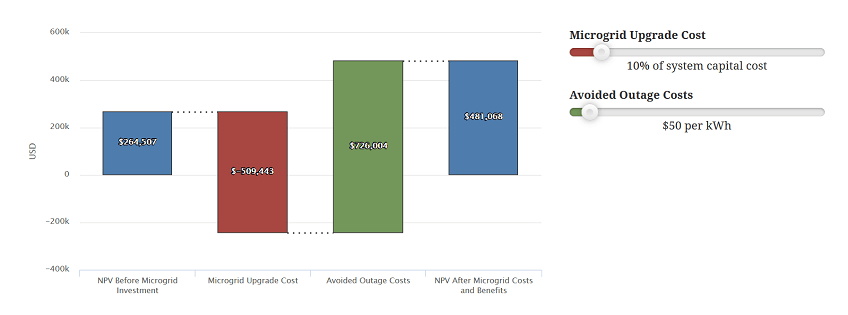Enhanced Resilience Features Help REopt Lite Users Size Solar+Storage Systems to Support Critical Building Loads
REopt™ Lite, the National Renewable Energy Laboratory’s (NREL’s) solar photovoltaics (PV) and battery storage optimization web tool, now offers enhanced resilience analysis capabilities that allow building owners and energy managers to size PV and storage systems to meet a specified outage duration. By giving users the ability to compare the sizing and costs of a resilient system with a system sized to maximize savings, the new release of REopt Lite will help decision-makers identify potential cost gaps and balance their economic and resilience goals.
“While we have historically measured the benefits of solar+storage in terms of cost and energy savings, resilience is emerging as another critical value,” said Kate Anderson, senior engineer and manager of the Engineering and Modeling Group at NREL. “REopt Lite’s new expanded resilience capability allows users to compare systems designed for maximum economic benefit to systems designed to sustain critical loads during grid outages, and assess the cost-benefit tradeoffs of different options. It also allows users to consider how varying microgrid upgrade costs and avoided outage costs may impact the economics of their system. We hope this will be a useful tool for decision-makers who are considering resilient solar+storage systems.”
REopt Lite’s enhanced resilient design features were developed in collaboration with Clean Energy Group through its Resilient Power Project and supported with funding from The Kresge Foundation and the Department of Energy’s Office of Energy Efficiency and Renewable Energy Federal Energy Management Program and Solar Energy Technologies Office.
“The updated version of REopt Lite marks a big step in the evolution of solar+storage analysis,” said Clean Energy Group Vice President Seth Mullendore. “It will help many of the organizations we work with every day—affordable housing developers, critical facilities managers, municipalities, and community groups—better understand the potential economic and resilience benefits that solar+storage could bring to their buildings, without having to rely solely on industry representatives and expensive consultants.”
REopt Lite’s new resilience inputs allow users to specify a site’s critical load as a percentage of the typical load, or they can upload hourly critical load data. An interactive plot of the critical load helps users determine which outage period to evaluate based on statistics such as average load, minimum load, maximum load, and the days on which minimum and maximum loads occur.
The tool provides users with the option of including existing PV systems and diesel generators in the resilience analysis. Users can specify the size of the existing PV system or diesel generator, along with the gallons of fuel available and other inputs such as the fuel burn rate and minimum loading. And, the tool lets users evaluate a major outage that might occur only once over an analysis period, or a typical outage that might occur annually.
Results from REopt Lite allow building owners and energy managers to compare systems sized for optimum savings to systems sized for resilience, and explore the impact of microgrid upgrade costs and avoided outage costs on project economics.
Effect of Resilience Costs and Benefits
The chart below shows the cumulative effect of resilience costs and benefits on the project's net present value. The microgrid upgrade cost and avoided outage costs are not factored into the optimization results.

A REopt Lite chart with interactive sliders helps users visualize the impact of microgrid upgrade costs and avoided outage costs.
Additional REopt Lite Features
REopt Lite's enhanced resilience features have also been implemented in the REopt Lite application programming interface (API). Released in March 2018, the REopt Lite API allows users and software developers to programmatically interface with the REopt Lite web tool, evaluate multiple sites and perform sensitivity analyses in an efficient manner, and integrate REopt Lite capabilities into other tools. In addition to the API release, REopt Lite developers have added a downloadable dispatch strategy and additional utility rates to the web tool.
REopt Lite is a publicly available web version of the more comprehensive REopt model. Learn more about NREL’s REopt analysis services at https://reopt.nrel.gov/.
Last Updated May 28, 2025
